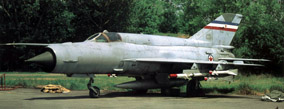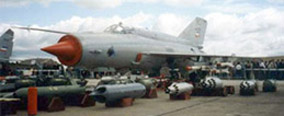MiG-21F
‘Fishbed-C’: Introduced in 1959, this first true production model was an improved
version of the MiG-21 with the R-11F turbojet rated at 38.25 kN dry and 56.39 kN with
afterburning, provision for a 490 liter centerline drop tank, and an armament of one 30 mm
NR-30 cannon plus either two AA-2 ‘Atoll’ short-range AAMs or two UV-16-57 multiple
launchers for 55 mm unguided rockets. In other respect, the MiG-21F differed from the
MiG-21MF except in details such as its length of 15.76 m including probe and 13.46 m
excluding probe, height of 4.10 m, empty normal take-off and maximum take-off weights of
4980, 7370 and 8630 kg respectively, maximum level speed ‘clean’ of 2125 km/h or Mach
2.00 at 11000 m, ferry range of 1670 km with drop tank, radius of 220 km on a hi-lo-hi
mission, maximum rate of climb at sea level of 7900 m per minute, and service ceiling of
about17500 m. The type was also built in Czechoslovakia without significant modification,
in China as the somewhat modified J-7, and in India as the HAL Type 74.
 |
MiG-21PF ‘Fishbed-D’:
This was the model introduced in 1960 with an inlet of increased diameter (to allow the
incorporation of a larger centerbody carrying the antenna for the R1L ‘Spin Scan-A’
interception radar that provided limited all-weather capability), an area-ruled fuselage,
greater power from the R-11F2S turbojet rated at 42.27 kN dry and 58.35 kN with
afterburning, and an internal fuel capacity increased to 2850 liters to mitigate the
earlier models problems of chronically short range. In other respect, the MiG-21PF differs
from MiG-21MF in details such as its length of 15.76 m including probe and about 14.00 m
excluding probe, height of 4.10 m, empty, normal take-off and maximum take-off weights of
5000, 8630 and 9300 kg respectively, maximum level speed ‘clean’ of 2125 km/h or Mach
2.00 at 11000 m, ferry range of more than 1670 km with drop tank, radius of more than 1670
km on a hi-lo-hi mission, maximum rate of climb at sea level of about 8300 m per minute,
and service ceiling of 17500 m. The MiG-21PF was also built under license in India as the HAL
Type 76, and late-production variants on the basic Soviet-built model were MiG-21PFS
with blown flaps and RATO capability, the NATO-designated ‘Fishbed-E’ with
broader-chord vertical tail surfaces and provision for a GP-9 underfuselage gun pod
carrying the 23 mm GSh-23L two-barrel cannon, and the MiG-21FL export model with
R2L ‘Spin Scan-B’ radar and the R-11-300 turbojet rated at 26.47 kN with afterburning,
but without blown flaps. This last was built under license in India as the HAL Type 77.
MiG-21PFM ‘Fishbed-F’:
Built between 1966 and 1968, this is the full-production model incorporating the various
improvements of earlier models, and thus having blown flaps, the R-11F2S-300 turbojet
rated at 38.20 kN dry and 60.80 kN with afterburning, provision for two SPRD-99
solid-propellant RATO units each rated at 24.51 kN, an internal fuel capacity of 2650
liters, a broader-chord vertical tail surface, and R2L ’Spin Scan-B’ radar. The type
also introduced a conventional cockpit enclosure, with fixed windscreen plus side-opening
canopy in place of the earlier models’ single-piece front-hinged unit. In other respect,
the MiG-21 PFM differs from the MiG-21MF in details such as its length of 15.76 m
including probe and about 14.00 m excluding probe, maximum take-off weight of 9300 kg,
maximum level speed ‘cleen’ of 2125 km/h or Mach 2.00 at 11000 m, ferry range of more
than 1670 km with drop tank, radius of more than 220 km on a hi-lo-hi mission, maximum
rate of climb at sea level of more than 7900 m per minute, and service ceiling of 17500 m. |
|
the MiG-21SM differs from the MiG-21MF in details such as its internal fuel
capacity of 2800 liters supplemented by up to three490 liter drop tanks, length of 15.76 m
including probe and about 14.00 m excluding probe, height of 4.10 m, maximum level speed
‘clean’ of Mach 2.00 at 11000 m, maximum rate of climb at sea level of 7900 m per
minute, and service ceiling of 17500 m. An improved version of the MiG-21SM, designated
‘Fishbed-K’ by NATO and at one time thought to be designated MiG-21SMT by the Soviets,
introduced a still larger dorsal fairing for greater fuel capacity and yet further
enhanced aerodynamics The subvariant also has provision for detachable ECM pods at the
wing and fin tips. The type was also built under license in India, and the export version
is the MiG-21M with the R-11F2S-300 turbojet rated at 38.20 kN dry and 60.80 kN
with afterburning, and after the end of the Soviet production program, which lasted from
1968 to 1971, production was transferred to India where the variant is known as the HAL
Type 96MiG-21MF ‘Fishbed-J’: Built between 1970 and 1975, this variant is derived
from the MiG-21M with the R-13-300 turbojet, RP-22S Saphir-21 radar and other electronics
of the MiG-21SM with the, together with provision for a 200 liter ventral drop tank.
MiG-21MT ‘Fishbed-?’:
This is a derivative of the MiG-21M with the electronics of the MiG-21MF but fitted with
the R-13F-300 turbojet and possessing a deepened dorsal spine extended rearward as far as
the brake chute housing to provide an internal fuel capacity of 3250 liters. The location
of so much fuel in the tail section adversely affected stability, therefore capacity was
reduced to 2950 liters, but the model was not deemed successful and production amounted to
a mere 15 aircraft in 1971.
MiG-21SMT ‘Fishbed-K’:
Built between 1971 and 1972, this is a MiG-21SM variant with the R-13F-300 turbojet and
the internal fuel capacity (original and then reduced) of the MiG-21MT in a dorsal fairing
extended aft as far as the brake chute housing to provide maximum fuel capacity consonant
with maximum wetted area.
MiG-21bis ‘Fishbed-L’:
Built in 1972, this is the initial third- generation development of the MiG-21 series with
the MNPK ‘Soyuz (Tumanski) R-25-300 turbojet rated at 40.26 kN dry and 69.63 kN with
afterburning in a re- engineered airframe which provides greater strenght at reduced
weight. Other changes include updated avionics and a further enlarged dorsal fairing to
allow an increase to 2900 liters of internal fuel that can can be supplemented by up to
one 800 liter and two 490 liter or three 490 liter drop tanks. In other respect, the
MiG-21bis differs from the MiG-21MF in its maximum disposable warload of 1500 kg, and
length of 15.76 m including probe and 14.70 m excluding probe.

|
MiG-21Mbis
‘Fishbed-N’: Also built in 1972, this is the definitive third-generation model
with further improvements to the avionics, in this instance characterized by the
‘bow-and-arrow’ probe on the nose for air-data sensors necessary for the accurate
delivery of air-to-surface ordnance. In other respect MiG-21bis differs from the MiG-21MF
in its maximum disposable warload of 1500 kg, powerplant of one R-25-300 turbojet rated at
40.26 kN dry and 69.63 kN with afterburning plus provision for two SPRD-99
solid-propellant booster rockets each rated at 24.51 kN, |
MiG-21S
‘Fishbed-J’: In most respects a straightforward development of the MiG-21PFM
9originally thought in the West to have been designated MiG-21PFMA), the MiG-21S built
between 1965 and 1968 marked the start of the MiG-21 series’ development into a
second-generation type offering dual-role capability as an interceptor and ground-attack
fighter. The variant introduced a radical enlargement of the dorsal fairing for reduced
drag plus extra avionics and a revised internal fuel capacity of 2600 liters, this
reduction being offset by provision for three 490 liter drop tanks. Other improvements
were the KM-1 ejector seat, more powerful RP-22S Saphir ‘Jay Bird’ radar with a search
range of 20 km, and four rather than two underwing hardpoints for the carriage of R-3
(AA-2-2 ‘Advanced Atoll’) as well as R-3 (AA-2 ‘Atoll’) AAMs. Early MiG-21S
fighters had provision for an external GP-9 gun pack, but later aircraft were fitted with
an internal GSh-23L cannon installation. In other respect, the MiG-21S differs from the
MiG-21MF in details such as its length of 15.76 m including probe and about 14.00 m
excluding probe, height of 4.10 m, maximum level speed ‘clean’ of 2125 km/h at 11000
m, maximum rate of climb at sea level of 7900 m per minute, and service ceiling of 17500
m.
MiG-21R ‘Fishbed-H’:
Built between 1965 and 1971, this is the tactical reconnaissance version of the MiG-21S
with a pack of three cameras (on a downward-opening starboard-hinged door) instead of the
cannon pack in the lower-fuselage bay just aft of the nosewheel, and also able to carry an
underfuselage pod (for optronic, optical or IR equipment) and tip-mounted ECM equipment
comparable to that of the ‘Fishbed-K’. The type has a deeper dorsal spine bulge
raising internal fuel capacity to 2800 liters, an AP-155 autopilot providing three-axis
stabilization rather than the roll-only stabilization of the KAP-2 autopilots used in
earlier variants, TsD-30 radar, and SPO-3 RWR. A similar model is the MiG-21RF
derived from the MiG-21MF but otherwise similar to the MiG-21R.
MiG-21SM ‘Fishbed-J’:
Built between 1968 and 1974, this improved version of the MiG-21S is powered by the MNPK
'‘Soyuz'’(Gavrilov) R-13-300 turbojet rated at 41.53 kN with afterburning for an
improved power/weight ratio as the engine provides greater thrust at lower installed
weight.Other modifications were the addition of a small rear-view mirror in a neat fairing
above the windscreen, the ASP-PFD sight better suited to close-turning combat,and improved
SPO-10 RWR. In other respects, |
|
internal fuel capacity of 2880 liters, external fuel capability up to one 800
liter and two 490 liter or three 490 liter drop tanks, length of 15.76 m including probe
and 14.70 m excluding probe, empty weight of 6200 kg, normal take-off weight of 8725 kg
with two AAMs, maximum take off weight of 10400 kg with two AAMs and three drop tanks,
maximum level speed ‘clean’ of 2175 km/h or Mach 2.05 at 13000 m and 1300 km/h at low
altitude, range 1470 km with two AAMs and one 800 liter drop tank at 10000 m or 1120 km
with two AAMs at 11000 m, maximum rate of climb at sea level of 17040 m per minute, climb
to 17000 m in 8 minutes 30 seconds, and service ceiling of 17500 m. The type can carry
R-60 (AA-8 ‘Aphid’) as well R-3 (AA-2 ‘Atoll’) AAMs, and after Soviet production
has been completed, manufacture of the MiG-21bis and MiG-21Mbis was transferred to India,
where HAL completed all production of the MiG-21 series with these variants in 1987.MiG-21U
‘Mongol-A’: Built between 1962 and 1968, this is the two seat conversion trainer
based on the MiG-21F but with the R-11F-300 turbojet, an internal fuel capacity of 2350
liters, the larger mainwheels and tires introduced on the MiG-21PF, and provision for a
ventral 12.7 mm heavy machine gun pod. The type was built under license in India as the HAL
Type 66-400 and Type 66-600.
MiG-21US ‘Mongol-B’:
Built between 1966 and 1970, this two-seat conversion trainer has broader-chord vertical
tail, flap blowing, and a deeper dorsal spine for an internal fuel capacity of 2450
liters. The instructor also has a retractable periscope for improved vision during
take-offs and landings, and in other respect the MiG-21US differs from the MiG-21MF in
details such as its powerplant of one R-11F2S-300 turbojet rated at 38.20 kN dry and 60.80
kN with afterburning, external fuel capacity of up to two 490 liter drop tanks, maximum
level speed ‘clean’ of 2150 km/h or Mach 2.02 at 12200 m, and maximum climb rate at
sea level of 6400 m per minute.
MiG-21UM ‘Mongol-B’:
Built in 1971, this two-seat conversion trainer was derived from the MiG-21MF with the
R-13 engine an updated instrumentation, but is otherwise similar to the MiG-21US. |

